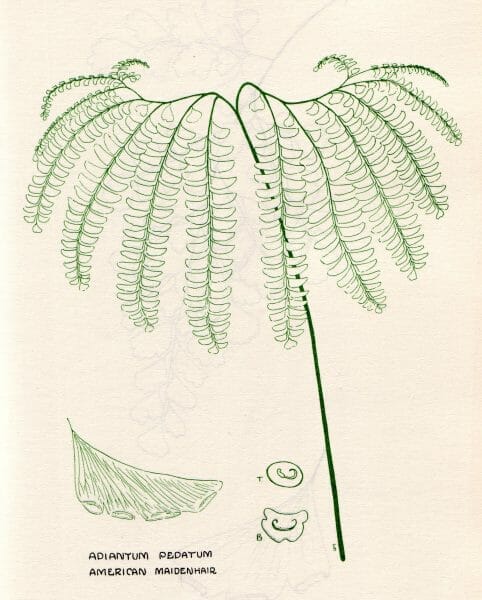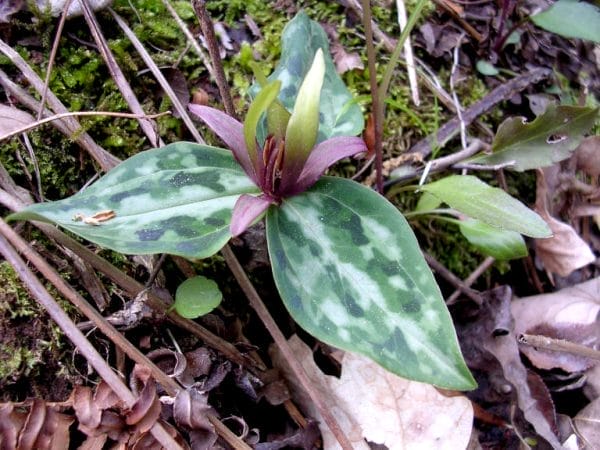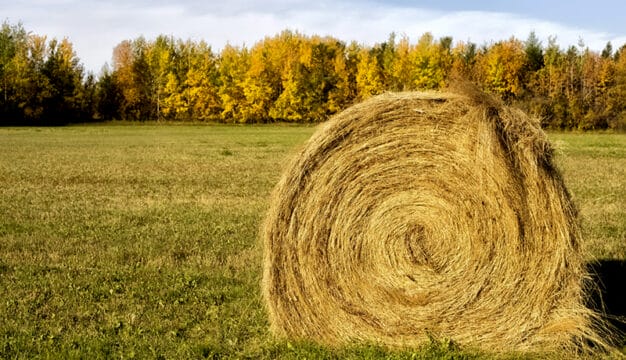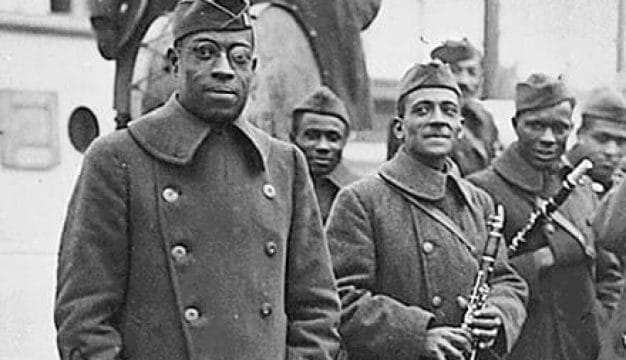Alabama Wildflower Society
The Alabama Wildflower Society (AWS) is a conservation group dedicated to promoting the preservation and knowledge of Alabama’s native plants. The society has seven local chapters with a main office located in Killen, Lauderdale County. The AWS has educational programs, newsletters, state meetings, and several scholarships available for students who are pursuing degrees in botany. The society appoints officers and accepts members using a dues system.
 Maidenhair Fern
The Alabama Wildflower Society was established through the efforts of conservationists Blanche Evans Dean, Mary Ivy Burks, and Louise “Weesie” Smith, who became concerned about increasing threats to native plants such as trilliums, ferns, green pitcher plants, sundews, and especially the Cahaba lily. These founding members also helped to establish the local chapters. Dean was one of the first naturalists to realize the diversity of Alabama’s native plants and the importance of protecting them. Burks pushed for the establishment of an Alabama Department of Transportation program to plant wildflowers on the side of state highways and also served on the Wilderness Feasibility Study Committee that was formed to educate Congress on the need to preserve the Sipsey Wilderness area. Smith in turn, served as the field botanist consulting on the ensuing Eastern Wilderness Areas Act of 1975 that created the Sipsey Wilderness in the Bankhead National Forest and protected its 12,000 acres of native plants and wildlife from timber and mineral extraction. The legislation was cosponsored by Alabama senators James Allen and John Sparkman. The efforts of these founding members helped to define the early mission of the AWS to protect the native plants and wildflowers of Alabama.
Maidenhair Fern
The Alabama Wildflower Society was established through the efforts of conservationists Blanche Evans Dean, Mary Ivy Burks, and Louise “Weesie” Smith, who became concerned about increasing threats to native plants such as trilliums, ferns, green pitcher plants, sundews, and especially the Cahaba lily. These founding members also helped to establish the local chapters. Dean was one of the first naturalists to realize the diversity of Alabama’s native plants and the importance of protecting them. Burks pushed for the establishment of an Alabama Department of Transportation program to plant wildflowers on the side of state highways and also served on the Wilderness Feasibility Study Committee that was formed to educate Congress on the need to preserve the Sipsey Wilderness area. Smith in turn, served as the field botanist consulting on the ensuing Eastern Wilderness Areas Act of 1975 that created the Sipsey Wilderness in the Bankhead National Forest and protected its 12,000 acres of native plants and wildlife from timber and mineral extraction. The legislation was cosponsored by Alabama senators James Allen and John Sparkman. The efforts of these founding members helped to define the early mission of the AWS to protect the native plants and wildflowers of Alabama.
 Relict Trillium
Currently, the Alabama Wildflower Society has seven local chapters that are actively working to protect native plants in their area. Each of these areas is unique in its diversity of plants and habitats. Local chapters are: the Bibb County Citizens for Wildflowers, the Blanche Dean Chapter (Greater Birmingham Area), Blount County Wildflower Society, Cullman Wildflower Society, Huntsville Wildflower Society, Shoals Wildflower Society, and George Wood Chapter (Tuscaloosa and West Alabama). Each local chapter holds events to educate the public and promote the conservation of native plants. The Blanche Dean Chapter has an annual wildflower walk in March. The Cahaba River is the site for the rare Cahaba lily that is only found in Alabama and small areas of the Southeast. The Huntsville Native Plant Society has a yearly plant sale at Huntsville Botanical Garden (HBG) and a plant identification hike on Monte Sano Mountain. The Holmes Trillium garden at HBG contains most of the native species of Alabama trilliums and is nationally accredited. The Cullman Native Plant Society hosts a native plant sale and manages a native plant garden at Sportsman Lake that includes a walking path through the garden.
Relict Trillium
Currently, the Alabama Wildflower Society has seven local chapters that are actively working to protect native plants in their area. Each of these areas is unique in its diversity of plants and habitats. Local chapters are: the Bibb County Citizens for Wildflowers, the Blanche Dean Chapter (Greater Birmingham Area), Blount County Wildflower Society, Cullman Wildflower Society, Huntsville Wildflower Society, Shoals Wildflower Society, and George Wood Chapter (Tuscaloosa and West Alabama). Each local chapter holds events to educate the public and promote the conservation of native plants. The Blanche Dean Chapter has an annual wildflower walk in March. The Cahaba River is the site for the rare Cahaba lily that is only found in Alabama and small areas of the Southeast. The Huntsville Native Plant Society has a yearly plant sale at Huntsville Botanical Garden (HBG) and a plant identification hike on Monte Sano Mountain. The Holmes Trillium garden at HBG contains most of the native species of Alabama trilliums and is nationally accredited. The Cullman Native Plant Society hosts a native plant sale and manages a native plant garden at Sportsman Lake that includes a walking path through the garden.
The AWS maintains the “Flowering Times Database” that documents the bloom period of more than 1,200 plants located in north Alabama and parts of Tennessee. Another flowering time database of more than 300 plants is maintained for the Great Smoky Mountains area, some of which are found in both states. The AWS website contains an officer directory, information about scholarship funding and other resources, and a gallery of images of local plants for identification. A Facebook page connects members to local events and features images of local wildflowers. Members can share comments, photos and find information on upcoming events in their area.
 Alabama Leather Flower
The Blanche E. Dean Scholarship Fund is an educational funding program awarded each fall by AWS. It awards scholarships to students of botany who are actively engaged in protecting, studying, or educating about the use of Alabama’s native plants. The AWS is also active in promoting legislation that preserves native plants and habitat and joined with the Native Plant Conservancy in 2017 to further those efforts. One of their most significant initiatives is obtaining passage of a “Botany Bill,” which would fund research for protection of native species and habitat recovery. Through the collaborative work of the seven chapters, the Wildflower Society promotes, protects, and educates the public on the importance of Alabama’s native plants. The state is one of the most biologically diverse in the nation and home to a vast amount of flora that require protection from unrestrained development. Alabama currently has 23 species of plants listed as endangered including the green pitcher plant, relict trillium, the whorled sunflower, the Alabama leather flower and many other threatened plants. As development continues across the state, it becomes more crucial to protect Alabama’s native species and habitats.
Alabama Leather Flower
The Blanche E. Dean Scholarship Fund is an educational funding program awarded each fall by AWS. It awards scholarships to students of botany who are actively engaged in protecting, studying, or educating about the use of Alabama’s native plants. The AWS is also active in promoting legislation that preserves native plants and habitat and joined with the Native Plant Conservancy in 2017 to further those efforts. One of their most significant initiatives is obtaining passage of a “Botany Bill,” which would fund research for protection of native species and habitat recovery. Through the collaborative work of the seven chapters, the Wildflower Society promotes, protects, and educates the public on the importance of Alabama’s native plants. The state is one of the most biologically diverse in the nation and home to a vast amount of flora that require protection from unrestrained development. Alabama currently has 23 species of plants listed as endangered including the green pitcher plant, relict trillium, the whorled sunflower, the Alabama leather flower and many other threatened plants. As development continues across the state, it becomes more crucial to protect Alabama’s native species and habitats.



